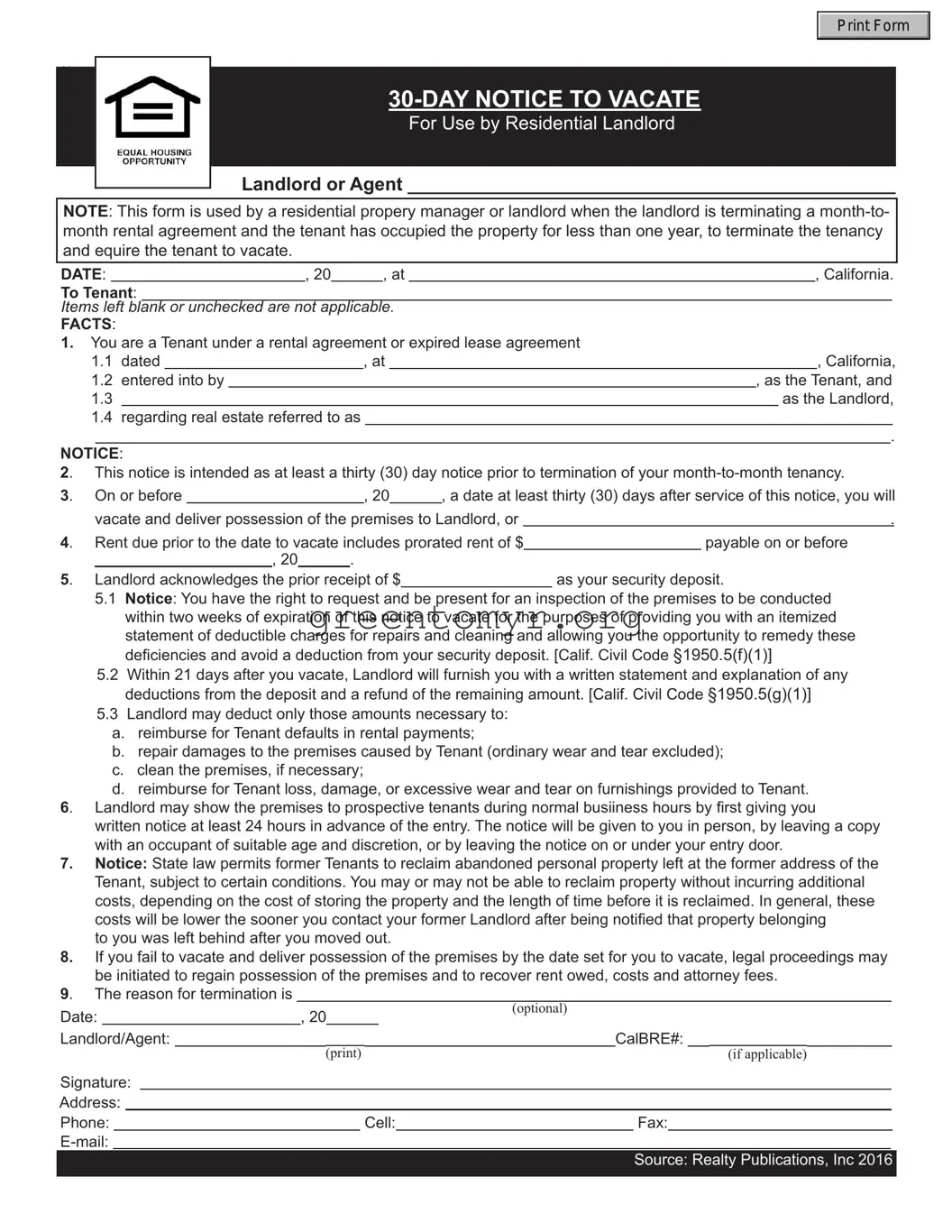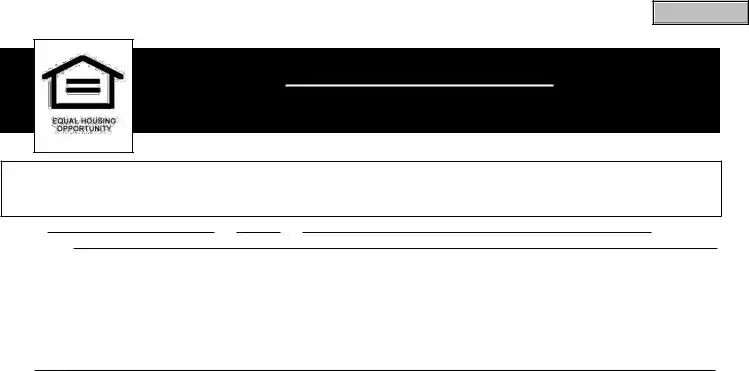Print Form
60
66030-DAY NOTICE TO VACATE
For Use by Residential Landlord
Landlord or Agent _______________________________________________
NOTE: This form is used by a residential propery manager or landlord when the landlord is terminating a month-to- month rental agreement and the tenant has occupied the property for less than one year, to terminate the tenancy and equire the tenant to vacate.
DATE:, 20 , at, California.
To Tenant:
Items left blank or unchecked are not applicable.
FACTS:
1.You are a Tenant under a rental agreement or expired lease agreement
1.1 |
|
dated |
|
, at |
|
|
, California, |
1.2 |
|
|
|
|
|
|
|
|
|
|
|
entered into by |
|
|
, as the Tenant, and |
1.3 |
|
|
|
|
|
|
|
|
as the Landlord, |
1.4 |
regarding real estate referred to as |
|
|
|
|
|
|
|
|
|
|
|
|
|
|
. |
NOTICE:
2. This notice is intended as at least a thirty (30) day notice prior to termination of your month-to-month tenancy.
3. |
|
On or before |
|
|
, 20 |
|
, a date at least thirty (30) days after service of this notice, you will |
|
|
|
|
|
|
|
|
|
|
|
|
|
vacate and deliver possession of the premises to Landlord, or |
. |
4. |
|
Rent due prior to the date to vacate includes prorated rent of $ |
|
|
payable on or before |
5. |
|
, 20 |
. |
|
|
|
|
|
|
|
|
|
|
|
|
|
|
|
|
|
Landlord acknowledges the prior receipt of $ |
|
|
|
as your security deposit. |
5.1Notice: You have the right to request and be present for an inspection of the premises to be conducted within two weeks of expiration of this notice to vacate for the purposes of providing you with an itemized statement of deductible charges for repairs and cleaning and allowing you the opportunity to remedy these deficiencies and avoid a deduction from your security deposit. [Calif. Civil Code §1950.5(f)(1)]
5.2Within 21 days after you vacate, Landlord will furnish you with a written statement and explanation of any deductions from the deposit and a refund of the remaining amount. [Calif. Civil Code §1950.5(g)(1)]
5.3Landlord may deduct only those amounts necessary to:
a.reimburse for Tenant defaults in rental payments;
b.repair damages to the premises caused by Tenant (ordinary wear and tear excluded);
c.clean the premises, if necessary;
d.reimburse for Tenant loss, damage, or excessive wear and tear on furnishings provided to Tenant.
6. Landlord may show the premises to prospective tenants during normal busiiness hours by first giving you written notice at least 24 hours in advance of the entry. The notice will be given to you in person, by leaving a copy with an occupant of suitable age and discretion, or by leaving the notice on or under your entry door.
7.Notice: State law permits former Tenants to reclaim abandoned personal property left at the former address of the Tenant, subject to certain conditions. You may or may not be able to reclaim property without incurring additional costs, depending on the cost of storing the property and the length of time before it is reclaimed. In general, these costs will be lower the sooner you contact your former Landlord after being notified that property belonging
to you was left behind after you moved out.
8.If you fail to vacate and deliver possession of the premises by the date set for you to vacate, legal proceedings may be initiated to regain possession of the premises and to recover rent owed, costs and attorney fees.
9. The reason for termination is |
|
|
|
|
|
|
|
|
|
|
|
|
|
|
|
|
Date: |
|
, 20 |
|
|
|
|
(optional) |
|
|
|
|
|
|
|
|
|
|
|
|
|
|
|
|
|
|
|
|
|
|
|
|
|
|
|
|
|
|
|
|
|
|
|
|
|
|
|
Landlord/Agent: |
|
|
|
|
|
|
CalBRE#: |
|
|
|
|
|
|
|
|
(print) |
|
|
|
|
|
|
(if applicable) |
|
|
|
|
|
Signature: |
|
|
|
|
|
|
|
|
|
|
|
|
|
|
|
|
|
Address: |
|
|
|
|
|
|
|
|
|
|
|
|
|
|
|
|
|
Phone: |
|
|
|
|
Cell: |
|
|
Fax: |
E-mail: |
|
|
|
|
|
|
|
|
|
|
|
|
|
|
|
|
|
|
|
|
|
|
|
|
|
|
|
|
|
|
|
Source: Realty Publications, Inc 2016 |
|
|
|
|
|
|
|
|
|
|
|
|
|
|
|
|
|
|
|
|
|
|

